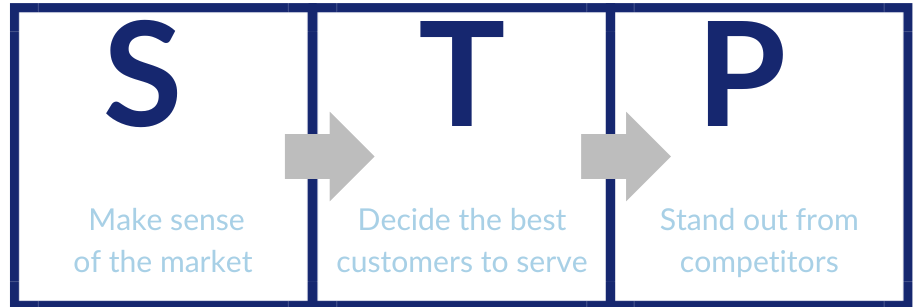eAccountable Framework Series
“Your customer isn’t ‘everyone’” – Seth Godin
While you might like it if ‘everyone’ bought your product, that isn’t how it works. Even the most popular brands in the world understand the diversity of their target market.
The truth is, there are going to be diverse groups of consumers who like your product for different reasons. The key to growing your business is finding out how to reach each of these diverse segments in the most effective way.
STP Marketing Framework
Want to know the best way to segment your audience? Say hello to the STP Marketing Model, a strategic framework used by businesses to identify and reach specific customer segments with tailored marketing campaigns that speak to them.
What does STP stand for? Segmentation, Targeting, and Positioning.

Without further ado, let’s dive into how to segment, target, and position your business for success.
Segmentation – Make Sense Of The Market
To create your customer segments, first you have to make sense of the market. You must divide your target market into distinct customer segments based on various criteria.
The criteria for B2C businesses usually include demographics (age, gender, income, etc.), psychographics (lifestyles, values, and interests), geographic location, behavioral characteristics (purchase behavior, product usage), or other relevant factors. B2B businesses focus on different criteria for segmenting, including industry, location, revenue, and customer needs. This is because they are targeting businesses and their stakeholders, not individuals.
The goal of segmentation is to group customers together who share common traits and needs and are buying your product for the same reason.
Think about the athletic shoe industry. There are a few different segments of consumers who buy these types of products. You’ve got consumers who are:
- Serious athletes
- Looking for comfortable shoes
- Looking for stylish shoes
- Looking for stable, supportive shoes
Your messaging should not be the same for each of these market segments, because they are each buying your product for different reasons.
Targeting – Decide The Best Customers To Serve
After segmenting the market, you should select one or more specific segments to target with your marketing efforts. You’ll want to test each segment to see which one will give you the biggest return on your investment.
There are many factors you need to evaluate in each segment before you choose to target one.
You’ll want to think about size—how big is this segment? The larger the segment, the more potential customers there are.
Next, you’ll want to think about growth potential and competition. Can this segment grow? When thinking about growth potential, you must factor in what the competition is—what companies are fulfilling this same need for this specific segment.
Then, you’ll want to take a look at profitability. You could have a large segment, but if their AOV (Average Order Value) is low, it won’t be as profitable as a smaller segment that buys more on every order.
Finally, you’ll want to think about reach. Can you practically reach this segment with your company’s current capabilities and resources? If you can, target them. If you can’t, find a more practical segment to target.
Use these factors to identify your target segments. Once you have chosen your target segments, they will become the focus of your marketing strategy.
Positioning – Stand Out From Competitors
So you’ve identified your target segments. What’s next? Positioning.
What is positioning? It’s standing out against the competition.
You’re not the only company targeting this target segment. You need to convince a whole group of customers that your product is better than the competition
Let’s return to athletic shoes.
Let’s say that you’re selling athletic shoes, and you’re targeting serious athletes. Your competition is Nike, Adidas, Puma, etc., who have been selling shoes to athletes for years. What is your value proposition?
To answer this question, you must ask yourself: What do serious athletes want in a shoe?
Well, they want a shoe that is:
- Supportive
- Stable
- Comfortable
- Aerodynamic
- Stylish
- Affordable
Your business might not have the brand recognition that Nike and Puma have, but you can convince them that your shoes are just as good quality and affordable too. Affordable will most likely be your key differentiating factor here, as Nike and Pumas can get away with charging a lot. At the same time, you’ll need to convince your audience that you’re affordable but not cheap. You need to position your shoes as supportive, stable, comfortable, aerodynamic, and stylish (all the other traits that the recognized brands have) and then use affordability as the final checkbox.
When you position yourself successfully, you create a positive and distinctive perception of your product and brand in the minds of your target customers.
What’s Next?
So, what do you do after you’ve created your segments, targeted your customers, and positioned your brand? You do it all over again, of course.
Your customers are always changing, which means their needs are always changing. And that means your target segments are always changing. You must keep a focused eye on your consumer behavior because the market is always evolving, and you can’t plug and play the same strategy over and over again.
Work With An Expert Team
The good news? You don’t have to STP all by yourself.
Sometimes it does help to have some fresh eyes on your target audience. Our hands-on account managers each have an average of 11 years of marketing experience and can find the most profitable segments of your audience to target.
Just drop us a line here for a free consultation and we can talk about some strategies to grow your business today.
